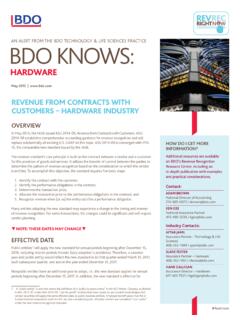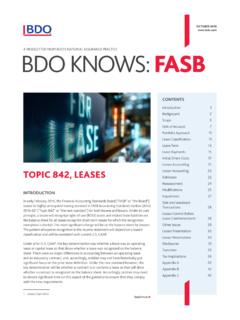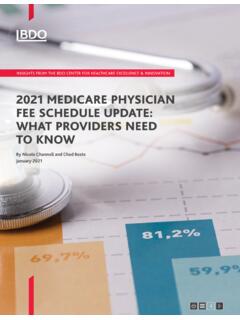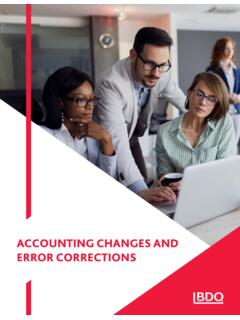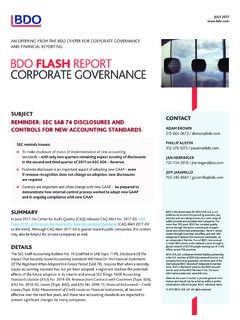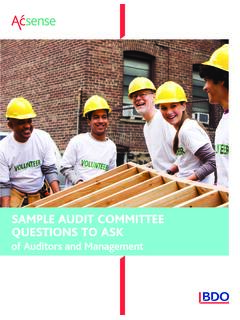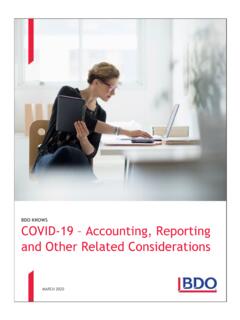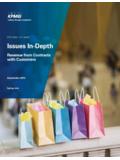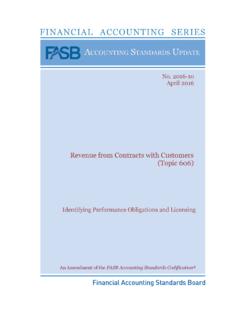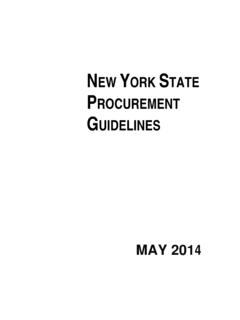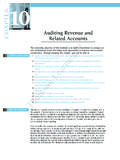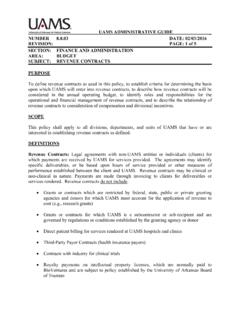Transcription of REVENUE FROM CONTRACTS WITH CUSTOMERS - bdo.com
1 REVENUE FROM CONTRACTS with CUSTOMERS MANUFACTURING INDUSTRY1 As promulgated in Accounting Standards Update (ASU) 2014-09, REVENUE from CONTRACTS with CUSTOMERS . Over the past three years, the Financial Accounting Standards Board (FASB) has issued various amendments to ASU 2014-09 based on operational issues raised by the FASB/IASB Joint Transition Resource Group and other practitioners. This publication reflects FASB amendments issued through December 31, A public entity is one that meets the definition of a public business entity in the ASC Master Glossary, as defined in ASU 2013-12, Definition of a Public Business Entity.
2 Under ASU 2014-09, not-for-profit entities that have issued (or are conduit bond obligors for) certain securities will apply the same effective date as public business entities. Employee benefit plans that file or furnish financial statements with the SEC are also considered public. Many other entities are considered nonpublic under the new REVENUE recognition standard. Please see (2)3 Early adoption is permitted for annual reporting periods beginning after December 15, 2016. Public companies that elect early adoption must also apply the new standard to interim periods within the annual period of adoption. Nonpublic companies electing early adoption may apply the new standard to interim periods within the annual period of adoption, or to interim periods beginning one year Companies have started gearing up to implement Accounting Standards Codification (ASC) Topic 606, REVENUE from CONTRACTS with Public entities2 must apply the new REVENUE recognition rules for annual periods beginning after December 15, 2017, including interim periods therein.
3 Therefore, a calendar year-end public entity would reflect the new standard in its first quarterly report for the period ending March 31, 2018, as well as for the entire year ending December 31, 2018. Nonpublic entities have an additional year to adopt. The new standard applies for annual periods beginning after December 15, 2018, and for interim periods within annual periods that begin one year later. Therefore, a calendar year-end nonpublic entity would first apply the new standard for the year ending December 31, 2019. If it also prepares interim financial statements, the new standard would first take effect for those interim periods in entities are permitted to early-adopt the new 606 establishes comprehensive accounting and disclosure guidance for REVENUE recognition and will replace substantially all existing GAAP on this topic.
4 The new guidelines will be substantially converged with IFRS 15, the comparable new standard issued by the International Accounting Standards Board (IASB).MANUFACTURING INDUSTRY CONSIDERATIONSThe core principle of the new REVENUE recognition guidance is focused on the contract between a vendor and a customer for the provision of goods and services. REVENUE is recognized when control over a good or service is transferred to the customer, and is based on the consideration to which the vendor is entitled. To accomplish this objective, the standard requires five basic steps:1. Identify the contract with the customer, 2.
5 Identify the performance obligations in the contract , 3. Determine the transaction price, 4. Allocate the transaction price to the performance obligations in the contract , and 5. Recognize REVENUE when (or as) the entity satisfies a performance FROM THE BDO MANUFACTURING PRACTICE Many entities adopting the new standard will experience changes in the timing and manner of REVENUE recognition. For some transactions, the changes could be significant and will require careful following examples demonstrate how the new guidelines may affect companies in the manufacturing industry. We encourage you to read these examples in connection with ASC 606 itself, and our publication BDO Knows FASB: Topic 606 REVENUE from CONTRACTS with CUSTOMERS , which describes the requirements of the new standard in more detail.
6 The examples and interpretations contained within this publication could continue to evolve. As we continue to study the new standard and monitor implementation efforts, we may update our guidance within this publication. REVENUE Recognition Over Time or at Point in TimeUnder existing GAAP, companies that produce certain customized products built to the customer s specifications apply contract accounting in ASC 605-35, Construction-Type and Production-Type CONTRACTS . Such companies are likely recognizing REVENUE using a percentage of completion method based on either:u Input measures, such as the cost-to-cost method, or u Output measures, including the units of production method.
7 Other companies may produce goods that do not fall within the scope of ASC 605 35. Revenues from these types of arrangements generally were recognized at a point in time, once substantially all of the risks and rewards ownership transferred to the customer. Under ASC 606, all contract manufacturers will need to evaluate whether the performance obligations should be recognized over time, or at a point in time. This evaluation is required regardless of whether the manufacturer had been previously applying contract accounting under ASC 605 35. It is possible that some contract manufacturers that currently recognize REVENUE using a cost-to-cost method under legacy GAAP , recognizing REVENUE over time will change to recognizing REVENUE at a point in time under ASC 606.
8 Conversely, some manufacturers that currently record REVENUE at a point in time under legacy accounting rules may be required to recognize REVENUE over time under ASC REVENUE recognition means that the manufacturer would recognize revenues once control over the finished products has transferred to the customer. Over-time REVENUE recognition means that the manufacturer would record revenues during and throughout the manufacturing process, even prior to delivering the completed products to the 606 requires over-time REVENUE recognition in any of the following three situations:1. The customer simultaneously receives and consumes the benefits provided by the manufacturer as it performs.
9 2. The manufacturer s performance creates or enhances an asset (for example, work in process) that the customer controls as the asset is created or enhanced. 3. The manufacturer s performance does not create an asset with an alternative use to the manufacturer, and the manufacturer has an enforceable right to payment for performance completed to date. For most manufacturers, only the second and third criteria above will be potentially applicable. For the second criterion, this requirement was included to address situations in which is it clear the customer controls the asset. One example is the integration of one customer-owned product into an additional component produced by the manufacturer, while another might be a contractual requirement for the customer to own and pay for all work in process.
10 In determining whether the second criterion is met, manufacturers should consider the indicators of control in paragraph 606-10-25-30. It may be generally clear that the product is controlled by the customer, but if it is unclear, the third criterion is INSIGHTS FROM THE BDO MANUFACTURING PRACTICE This third item contains two components, which are described further in the following table: 4 Manufacturer s performance does not create an asset with an alternative use to the manufacturerManufacturer has an enforceable right to payment for performance completed to dateA manufacturer could create an asset that has no alternative use in one of two ways.
